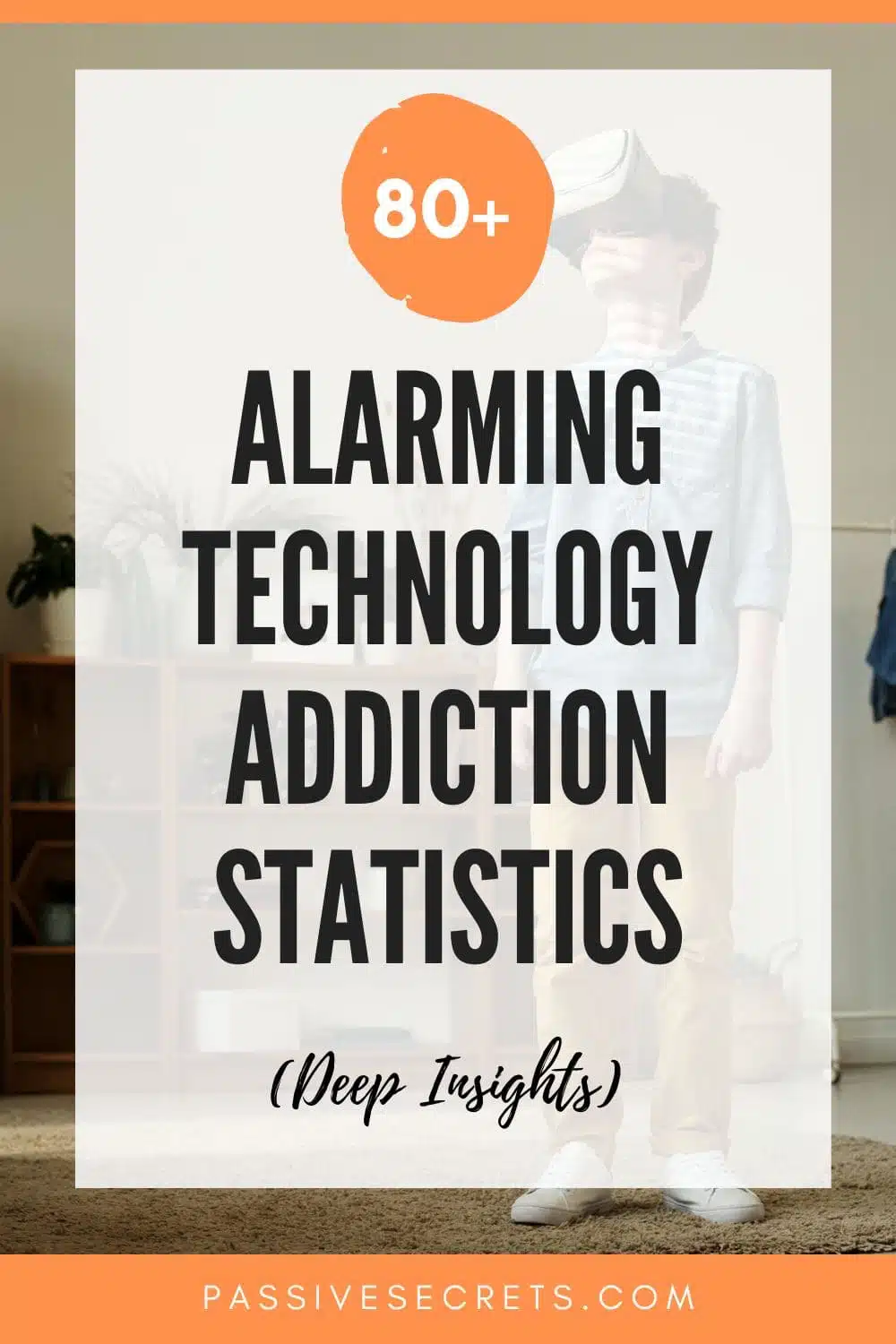
Technology is the greatest innovation man has ever made.
The growing number of the internet and mobile devices has given us easy access to technologies that were unthinkable 50+ years ago.
However, everything has two sides — the good and the dark sides.
And yes, so does technology. As great as technology is, it is very addictive.
The fascinating nature of technology has made people addicted.
Technology addiction is very dangerous. For example, spending too much time on the internet is detrimental to both your physical and mental health.
People all across the world are spending more time on social media, playing computer games, and browsing the web without thinking about how it will affect them.
Since technology is so ingrained in our everyday lives, most people don’t consider it an addiction.
Let’s check out the latest technology addiction statistics to see just how much this addiction can affect our daily lives.
Key Technology Addiction Statistics (Editor’s Pick)
- According to a survey of internet users in the United States, nearly half of those polled (48%) deemed themselves addicted or somewhat addicted to digital devices.
- According to a study commissioned by Vision Direct, the average American adult will spend 44 years of their life staring at screens.
- According to a survey, the majority of teenagers (77%) reported feeling anxious when they were without their cell phones.
- A survey done in 2022 found that younger generations in Russia are more addicted to electronic devices and the internet.
- Americans check their phones 144 times every day.
- The majority of people (54%) prefer to spend time on their phones rather than in the presence of their partner.
- More than half of Americans claim they haven’t gone more than 24 hours without their phone.
- According to 31% of parents, the third most common cause of disagreement between parents and teenagers is screen usage.
- According to a Qualtrics survey, 79% of Millennials sleep with their phones close by, with 53% waking up at least once a night to check them.
- According to a 2022 internet addiction test the majority of prevalence studies indicate that internet addiction affects between 1% and 10% of the population.
General Technology Addiction Statistics
1. According to a 2022 survey of internet users in the United States, nearly half of respondents (48%) deemed themselves addicted or somewhat addicted to digital devices. (source)
2. According to Ofcom’s Report 2023, the typical person in the United Kingdom spends 8 hours and 41 minutes using an electronic device rather than sleeping. (source)
3. 33.33% of technology users find it difficult to disconnect from their devices. (source)
4. It is estimated that children and teenagers aged 8 to 28 spend approximately 44.5 hours each week in front of digital screens. (source)
5. Approximately 23% of children and teenagers have reported feeling addicted to video games. That translates to 31% males and 13% females. (source)
6. In the U.S., adults spend over 6259 hours yearly glued to their digital gadgets. (source)
7. The average American adult will spend 44 years of their life staring at screens. (source)
8. Smartphones take up to 4 hours and 33 minutes of an adult’s daily screen time. (source)
9. The average adult takes less than 10 minutes to look at the screen after waking up. (source)
Social media is often the first thing checked. 38% of adults say that social media has most of their screen time.
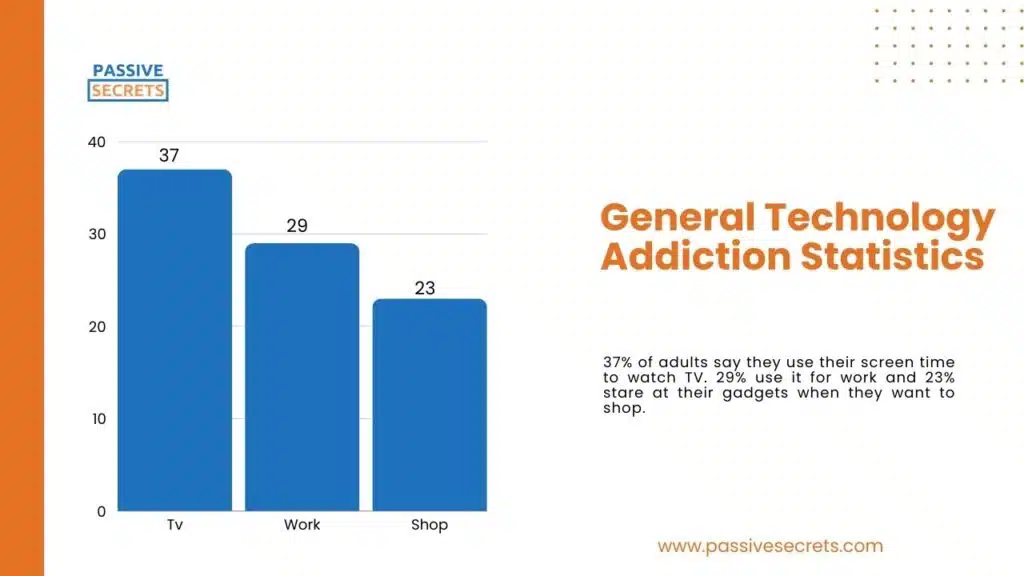
10. 37% of adults say they use their screen time to watch TV. 29% use it for work and 23% stare at their gadgets when they want to shop. (source)
11. 6 in 10 adults in relationships have argued with their partner about how much time they spend staring at screens. (source)
12. Almost half of parents believe their children spend too much time focused on their gaming gadgets or phones. 41% find it difficult to limit how much screen time they allow. (source)
13. 7 in 10 adults report that excessive screen time strains their eyes. Nevertheless, 4 out of 10 of them don’t remember to rest their eyes every hour, and 20% never do. (source)
14. The average adult spends fewer than 10 minutes each day looking at a screen after waking up. With 6 out of 10 doing so within 5 minutes. (source)
15. On average, 4.5 hours are spent watching TV, nearly 5 hours on laptops, and 3 hours and 12 minutes on gaming devices each day. (source)
16. About half of the teens in the US feel addicted to smartphones. (source)
17. A significant 90% of Americans feel disrespected if someone they are conversing with is distracted by their phone. Surprisingly, three-quarters admit to doing it, with over 20% doing it on a regular basis. (source)
18. Those in affluent households (39%) find it harder to disconnect from tech compared to their counterparts in low-income households (30%). (source)
19. According to a survey, the majority of teenagers (77%) reported feeling anxious when they were without their cell phones. (source)
20. A striking 65% choose to sleep close to their smartphones. (source)
Technology Addiction Statistics By Country
21. Younger generations in Russia are more addicted to electronic devices and the internet. (source)
Over half of respondents under the age of 25 in Russia acknowledged having a digital addiction.
22. In Russia, over one-third of persons over the age of 45 reported signs of device and internet addiction. (source)
23. South Africans lead in daily internet usage with 9 hours and 38 minutes. Followed closely by Brazilians at 9 hours and 32 minutes, while Japan averages 4 hours daily, the lowest among the three countries. (source)
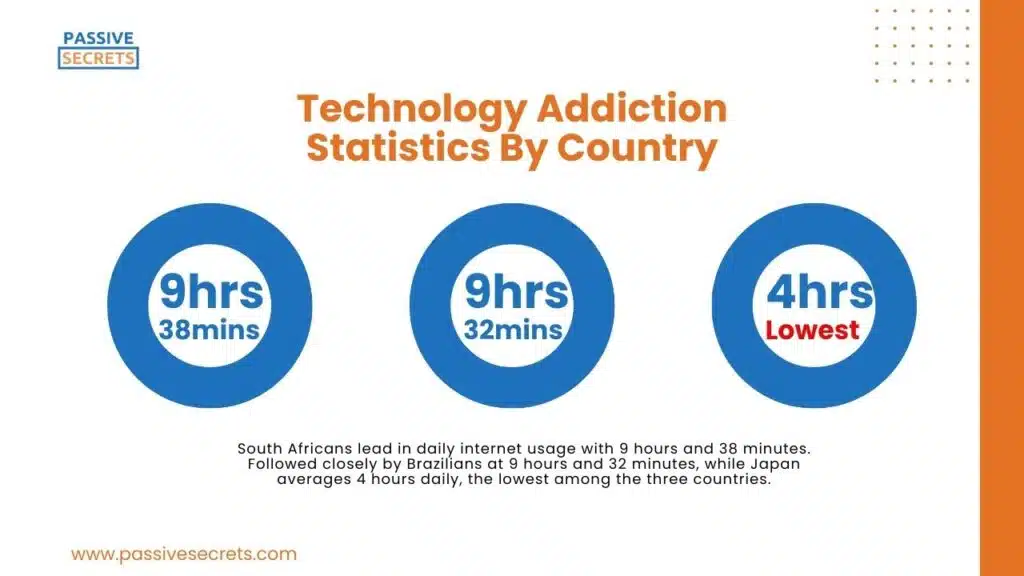
24. 56.9% of surveyed Americans admitted they were addicted to their cell phones. (source)
25. According to a survey conducted by Reviews.org, Americans check their phones 144 times every day. (source)
26. 75% of Americans are reluctant to leave their phones at home. (source)
27. In 2023, children in the United Kingdom spent an average of 127 minutes a day on TikTok. Instagram was the next most popular app, with children in the UK spending an average of 40 minutes a day on it. (source)
28. On average, Brazilians spend 41 years, 3 months, and 13 days of their life on the internet. (source)
However, Hong Kongers spend over 44 years browsing online.
29. The average Australian spends up to 9 hours and 14 minutes every week, after work. (source)
30. The Japanese have the least amount of time on the internet, spending only 11 years, 4 months, and 13 days. (source)
31. In Germany, residents dedicate 5 hours and 19 minutes weekly to streaming videos. They also dedicate 4 hours and 12 minutes per week on social media. (source)
The French do something similar. They dedicate 6 hours and 39 minutes weekly to social media and 6 hours and 18 minutes weekly to streaming movies.
32. Americans spend the most time streaming movies on video platforms like Netflix – an average of 5 hours and 23 minutes weekly. (source)
33. UK residents spend an average of 4 hours and 36 minutes weekly playing online games. (source)
34. Canadians dedicate 8 hours and 19 minutes weekly to social media. (source)
35. Over 50% of surveyed UK residents admitted they can’t go a day without using the internet. (source)
36. 37% of French respondents between the ages of 18 and 34 years considered themselves addicted to digital devices. (source)
37. A Polish survey noted that young people are the most likely to get addicted to the internet. (source)
Respondents in the survey also listed lonely people, children, and less-busy people as more likely to have an internet addiction.
38. One in five Brits (22%) agree they are addicted to television, and one in fourteen (7%) think they definitely are. (source)
Smartphone Addiction Statistics
39. On average, 71% of individuals prioritize phone time over time with their partner. 52% reported dedicating an extra three to four hours daily to their phones than to their romantic partners. (source)
40. 80% of women check their phones before saying ‘good morning’ to their partners. (source)
Over three-quarters (78%) of women admit to spending more time on their phones than with their love partners, compared to 64% of males.
41. Alarmingly, 17% of women said they will interrupt lovemaking or intimacy to check their phones. (source)
42. Majority of people (54%), prefer to spend time on their phone than in the presence of their partner. (source)
43. A quarter (25%) of adults say cell phone use has caused disagreements in their relationship. 28% of men claim phone use has prompted arguments, but only 22% of women say the same. (source)
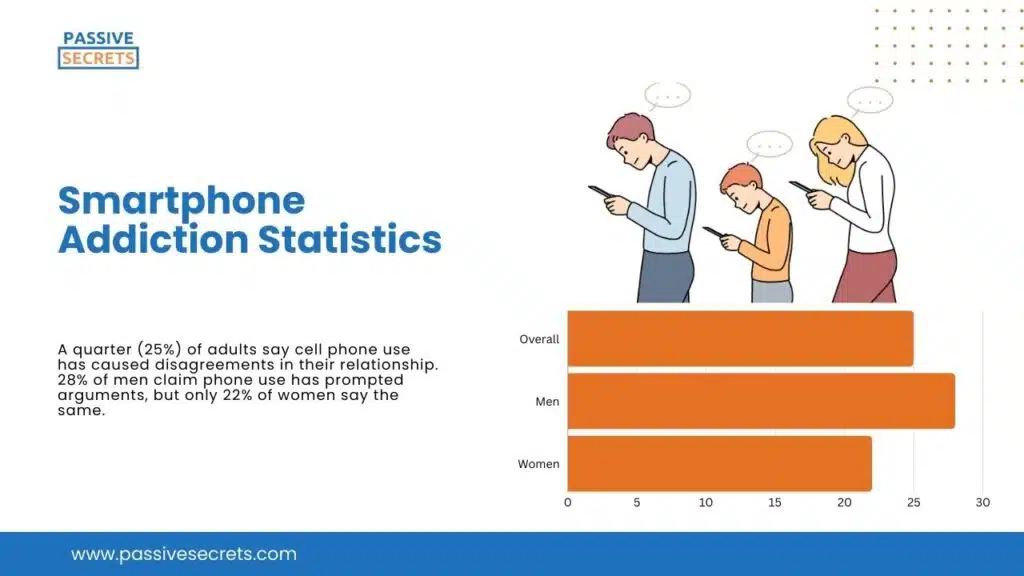
44. Almost half of Americans say they’re addicted to their phones. (source)
45. 75% of Americans check their phones within five minutes of receiving a notification. (source)
46. Silencing mobile phones (no sound or vibrations) leads to increased mobile phone use and phone-checking behaviors in general. (source)
47. More than half of Americans claim they haven’t gone more than 24 hours without their phone. (source)
48. There are 6.84 billion smartphone users in the world. The number is predicted to rise to 7.1 billion before the end of 2024. (source)
49. The average American smartphone owner unlocks their phone 150 times daily. (source)
50. According to 31% of parents, the third most common cause of disagreement between parents and teenagers is screen usage. (source)
51. 48% of teenagers spend more time socializing with close friends online than in person. 40% of them socialize more in video games than offline. (source)
52. 52% of teens sit silently, looking at their smartphones for long periods of time when they are with friends. (source)
53. 45% of people have texted or used their phone while driving. (source)
54. The majority of Gen X (52%) and Millennials (52%) admit to using their phones while driving. (source)
55. 79% of Millennials sleep with their phones close by, with 53% waking up at least once a night to check them. (source)
56. When asked about productivity, 13% of Americans strongly agreed that they could be more productive if they did not have their smartphone with them. (source)
57. Users with a high Fear of Missing Out will use their phone far more when it is in silent mode. (source)
Social Media Addiction Statistics
58. 40% of American internet users between the ages of 18 and 22 said they had a social media addiction. (source)
59. 5% of respondents aged 18 and 22 said they thought the statement “I am addicted to social media” represented them perfectly. (source)
60. Over 70% of adults from some countries use social media as a news source. These countries are the Philippines, Malaysia, South Africa, Kenya, and South Africa. (source)
61. Overall, 34% of female internet users in the United States reported feeling addicted to social media. (source)
11% of female respondents said they thought the statement “I am addicted to social media” represented them perfectly.
62. Individuals from lower socioeconomic backgrounds may be more likely to exhibit problematic social media use. (source)
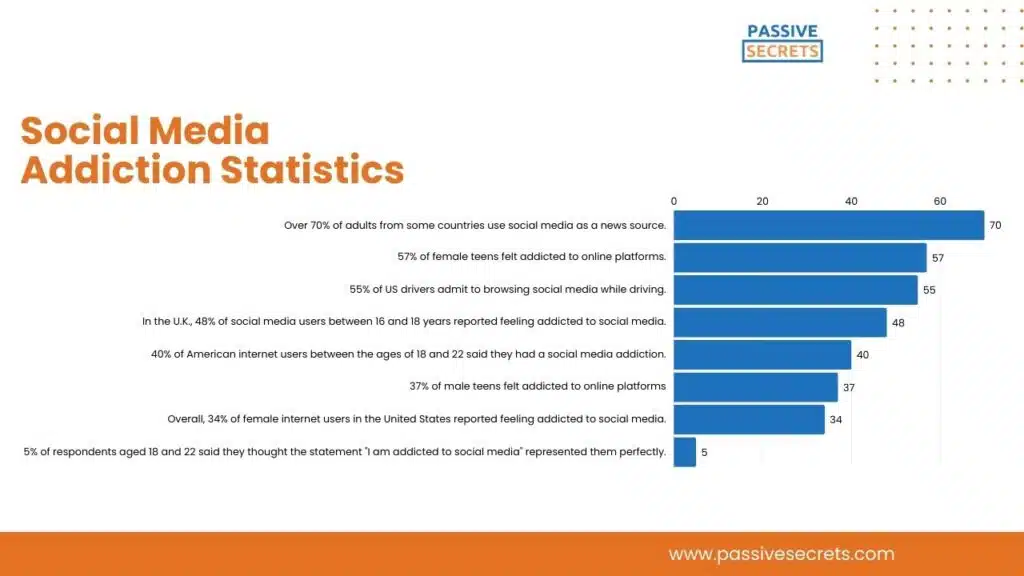
63. 55% of US drivers admit to browsing social media while driving. (source)
64. According to a study, getting “likes” on social media stimulates the same brain circuits in teenagers that are triggered by earning money or eating chocolate. (source)
65. According to Nicholas Kardaras, author of Glow Kids, persistent overstimulation from social media networking causes the neurological system to enter fight-or-flight mode. This worsens problems like ADHD, teen depression, oppositional defiant disorder, and teen anxiety. (source)
66. Frequent use of social media really rewires the developing teen brain to always seek instant pleasure. As a result, it can lead to other addictive behaviors. (source)
67. In the U.K., 48% of social media users between 16 and 18 years reported feeling addicted to social media. (source)
57% of female teens felt addicted to online platforms, compared to 37% of boys.
Internet Addiction Statistics
68. 13.7% of internet addicts struggle to stay away from the internet for multiple days at a time. (source)
69. 12.4% of internet users spend more time online than they anticipated, very regularly or frequently. (source)
70. The typical internet user spends 6 hours and 42 minutes online every day. (source)
71. According to a 2022 internet addiction test the majority of prevalence studies indicate that internet addiction affects between 1% and 10% of the population. In contrast, Asian researchers discovered rates as high as 25%. (source)
72. In another study 4.1% of students were internet addicts. Also, the study found that 28.5% of the students were at risk of having internet addiction. (source)
73. According to Statista, the Philippines spends an average of 8.52 hours daily on the internet. (source)
74. Around 40% of people have an internet-based compulsive disorder. (source)
75. According to the International Journal of Neuropsychiatric Medicine, approximately 1 in 8 Americans experience problematic internet use, with rates reaching up to 30% in certain countries globally. (source)
76. According to Quartz, South Africa is the world’s most internet-addicted country. (source)
South Africans spend at least 9.5 hours online daily. Brazil, the Philippines, Argentina, and Columbia also top the list of internet-addicted countries.
77. 34% of Chinese ethnicity respondents in Malaysia admitted to having internet addiction. (source)
Gaming Addiction Statistics
78. 3-4% of players are hooked to video games, and 8.5% of young people aged 8 to 18 suffer from gaming disorders. (source)
79. Researchers discovered that between 0.3 and 1.0 percent of the general population could be diagnosed with internet gaming disorder. (source)
80. A 2021 systematic review and meta-analysis 2 revealed that the global prevalence of gaming disorder is 3.05%. This suggests that gaming disorders could affect up to 60 million people (or more). (source)
81. According to a new global poll, gamers spent approximately 8 hours and 27 minutes each week playing games, up 14% from 2020. (source)
82. Male teenagers are more prone than female teens to develop internet gaming disorder (IGD). (source)
19% of male teenagers have gaming disorders, compared to 7.8% of females. Teens spend an average of 2 hours daily on gaming.
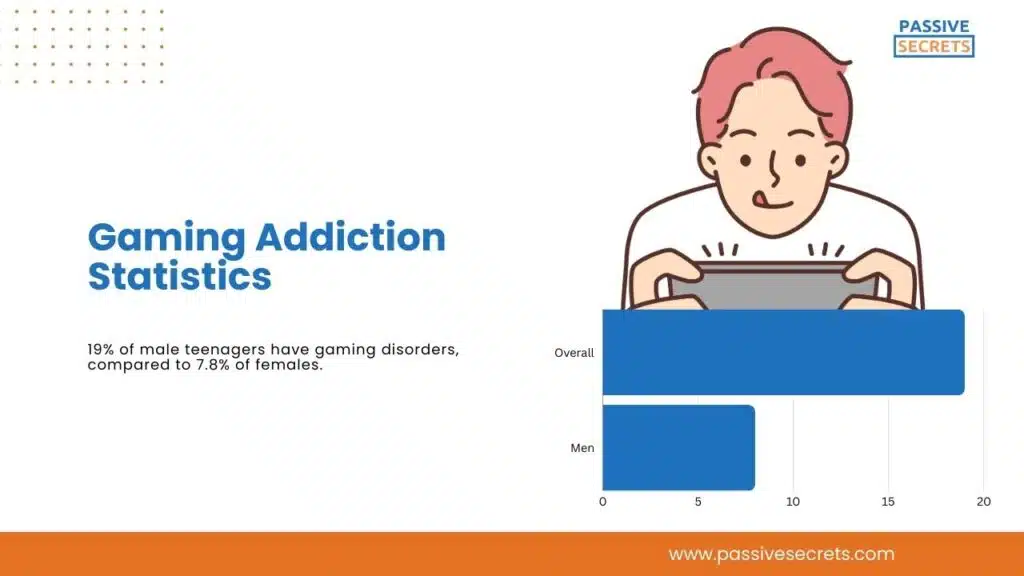
Final Thought
Although it is less common than gambling or alcoholism, technology addiction is real and has already affected millions of individuals around the world.
With these technology addiction statistics, you can raise more awareness about the unhealthy effects of “too much” technology.
FAQs
1. How is technology addictive?
Technology can be addictive because it triggers happy brain chemicals, provides instant rewards, and offers unpredictable surprises.
2. What are the facts about using technology too much?
One key fact about too much technology is that it can lead to poor posture and eye strain. Too much screen time can cause sleep problems.
3. What is digital addiction?
Digital addiction is an impulse control problem characterized by obsessive use of digital devices, digital technologies, and digital platforms. Such as the internet, video games, online platforms, mobile devices, digital gadgets, and social networking platforms.
4. What is another word for technology addiction?
Other terms for this addiction include Internet addiction disorder (IAD) and net addiction.
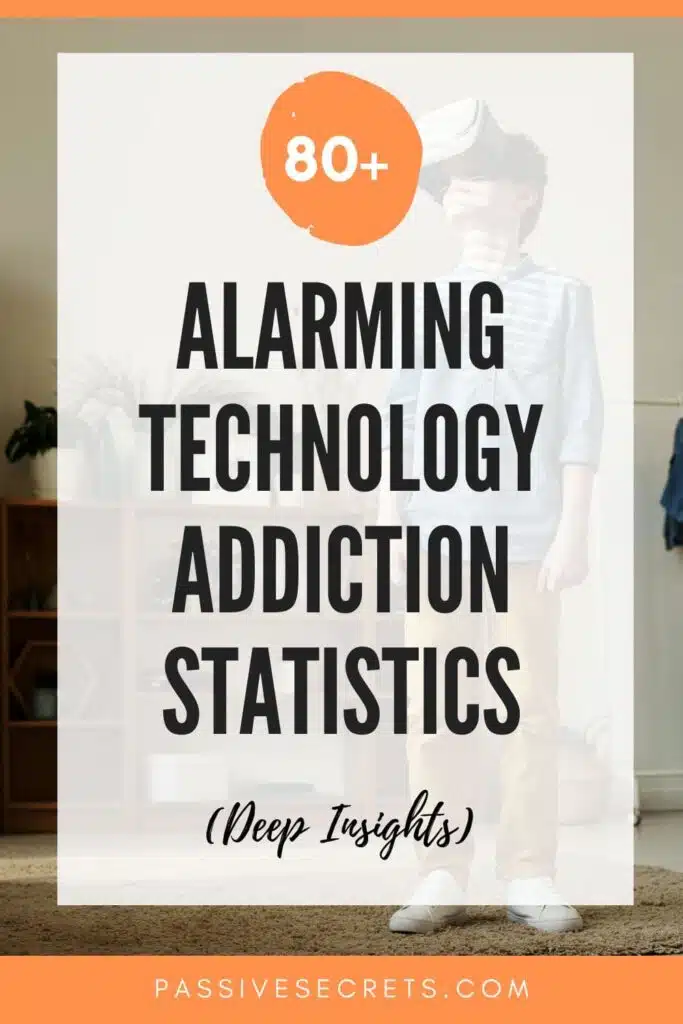
Related Posts:
- Thought-Provoking Gender Inequality Statistics: 160+ Insights Across Regions
- 110+ Shocking Income Inequality Data You Need to Know
- 50 Interesting Sharing Economy Statistics You Need to Know
- 100+ Animation Statistics: The Ultimate Guide To The Industry’s Trends and Insights
- 80+ Franchise Statistics and Facts You Should Know In 2024
- The Future of Learning: 50+ Top EdTech Statistics For 2024
- The Web3 Statistics Report 2024: Trends, Insights, and Predictions
- Meme Statistics 2024: Facts, Trends, and Figures That Will Blow Your Mind
- 85+ MOST Interesting Anime Statistics and Facts (NEW Report)
- Board Game Statistics: Revenue, Market Size, Demographics & More
- 125+ Interesting Airbnb Statistics by Country (Deep Insights)
- 50+ Interesting Born Into Poverty Stay In Poverty Statistics
- 90+ Interesting Film Industry Statistics (NEW Report)
- 65+ Impressive Chess Statistics and Facts To Know in 2024
- Spotify Statistics: Latest Report on The Music Streaming Platform
- 50+ Useful Video Game Addiction Statistics, Facts & Huge Trends
- 50+ Vital Internet Safety Statistics & Facts You Must Know
- Internet Dangers Statistics: A Look At The Internet’s Dark Side
- 50 Interesting Bible Statistics and Facts You Didn’t Know
- 95+ Interesting Dream Statistics and Facts You Can’t Miss
- 75+ Interesting Relationship Statistics & Facts You Should Know
- Dance Statistics: A Deep Dive Into The Rhythm Of Movement
- 40+ Incredible Single Father Statistics You Have to Know
- The Battle of the Sexes: Male Vs. Female Spending Statistics
- 95+ Jaw-Dropping Period Poverty Statistics You Need To Know
- 70 Exciting Love Statistics And Facts (True Love, Intimacy, Marriage, Dating & Relationships)
- 30+ Gentle Parenting Statistics & Facts: Is This Parenting Style Worth It?
- 55+ Useful Black Consumer Spending Statistics (2024 Report)
- Holiday Spending Statistics: Valentine’s Day, Easter, Thanksgiving, & Christmas

